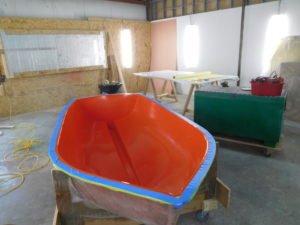
While I was willing, as the last blog post illustrates, to paint in almost all conditions in order to get Ganymede finished in time, even I had to draw the line at rain. On rainy days—of which there were plenty—I tried to get some work done on the dinghy project. We last left the new mold empty of the plug and ready for quick localized repairs followed by buffing and coating with with Axel mold release agent. After that, there was nothing to stop the beginning of work on the dinghy itself.
My primary purpose in the dinghy project was to build a boat that Danielle could carry more easily, so I had determined to make it from Kevlar and carbon fiber: Kevlar so it could be dragged over a thousand rocky beaches without more than the inevitable cosmetic damage, and carbon fiber to make it stiff and keep it lightweight. Of course, in shopping for deals on the cloths I wanted, ran into all sorts of exciting new exotic materials: Vectran, Innegra, carbon/dyneema, and other fancy blends. All tempting, but in the end I stuck with an old-fashioned tight-weave Kevlar that I found on closeout, and the standard carbon twill.
After spending a day carefully cutting out all the materials and stacking them in order, as well as preparing the vacuum bagging materials, I was ready to mix resin. And on the next frightfully rainy day, with the help of a former shipmate who thought he wanted to learn all about this stuff (and who am I to discourage learning?), we started mixing epoxy and rolling it into the mold. I chose Pro-set 135 epoxy resin with a slow hardener—one that would allow us several hours of working time before kicking off. This gave us time to take it slow and careful, making sure to get each layer down neat and tidy before the next. At first the contrast between bright yellow Kevlar and the orange mold was quite astonishing, but we were soon into the soothing black of carbon fiber, and in less than four hours all the material was in place.
I had built the mold with vacuum-bagging in mind, which is one of the best ways to get a really good, tight laminate. After laying in the vacuum stack: peel ply first, then Tedlar release film, then a blanket-like material called “breather” to allow air to flow, we taped a big sheet of vacuum-bag plastic to the flange with double-sided butyl tape. Then we turned on a borrowed vacuum pump. As the pump sucked all the air from the bag, it pressed down tighter and tighter, until resin came seeping through the breather.
After a couple of days to let the resin get good and stable (though it didn’t reach it’s full properties until I post-cured it with heat later), I pulled back the vacuum bag and laid a piece of foam core covered with carbon and kevlar into the transom, then vacuumed the bag down again. After that the bag was done with and I could begin getting in the seats, foredeck, and gunwale.
It’s astonishing how much more time-consuming all the details can be than the actual layup of the hull. It took many small steps to get the seat-rails cut, fitted, and tabbed on both sides; it took several days to cut core foam and carbon for the gunwales and to actually get them installed. But at last those details were done and the dinghy could come out of the mold. This it did more easily than any object I’ve ever de-molded, and was astonishingly light, lighter than I had dared to expect.
Sadly, the outside of the hull was fraught with blemishes: not fatal ones, just cosmetic flaws that left her looking almost like a lunar landscape in spots. It turns out that a combination of the kevlar being too tight a weave, and the resin being overly viscous, especially in the cold of spring, prevented all the outer surface bubbles from being sucked out by the vacuum bag. Live and learn, I guess—at least my layup was good and tight, and it didn’t take too long to fill in and fair the lunar landscape.
By now the weather had improved enough to move out of my borrowed shop space, which had got me admirably though the winter, but now felt far enough away from home to make it a bother to go. So I moved the whole circus back into my two little garage units, set the dinghy on sawhorses under the big shade tree in the yard, and started on the home stretch. There are still details innumerable to attend to, but being able to step out of the kitchen and slosh on some paint or whatever without having to drive three towns over will definitely speed things up. I only hope I can get it launched before half the summer’s gone.

















